Are you looking for cheap tours to China? China Tour Star has prepared this 10-day China Cheap Tour for you. In this tour, you will visit many attractions with low ticket prices but very worth visiting, such as Jingshan Park, Olympic Park, Chengdu People's Park and so on. In addition, you will not miss must-see attractions like the Forbidden City and the Great Wall. In addition to the cheap tours in Beijing, you will also go to Chengdu, the hometown of giant pandas. You will watch giant pandas in the place with the most giant pandas. Finally, your China tour will end in Shanghai. There are many direct flights between Shanghai and almost all western countries, which also helps you choose more cost-effective international flights. Come and join us on this quality budget China tour!

We are pleased to meet you in China. Your guide in Beijing is waiting for you at the airport and will transfer you to the local hotel for a rest. We will try our best to make your stay in China a pleasant one. Get ready for your wonderful trip to China.
Beijing, once the capital of six dynasties in history and now the capital city of the People’s Republic of China, enjoys a large number of cultural relics. Beijing’s layout is symmetrically designed around the central axis. Its most typical and characteristic dwellings are Siheyuans (quadrangle courtyards) in the Hutong area, which is worth visiting. Hutong, meaning small streets and alleys, originated in the Yuan Dynasty (1271-1368), and there are more than 7,000 large and small Hutongs scattered in Beijing, each with a legend. Siheyuan is a traditional Chinese residential building. A standard Siheyuan usually has a large courtyard surrounded by houses along its four sides.
After breakfast, you will visit Tian’anmen Square, the Forbidden City, and Jingshan Park.
Tian’anmen Square was built in 1420. It was widened later. Monument to the People’s Heroes was built in the center of the square. You will also find the Great Hall of the People on the west side of the square, the Chinese National Museum on the east side, and Chairman Mao Memorial Hall on the south. Tian’anmen Gate Tower stands at the north of the square. The five archways below the gate tower are the main entrance of the imperial city in the Ming (1368-1644) and Qing (1636-1912) Dynasties. It also reflects the supremacy of imperial power, because, in the past, the largest gate in the middle is only for the emperor; the next two are set up for the royal clan; the outermost two are for high-ranking officials. Since the founding of New China, every military parade has been held here, and Tian’anmen Square has become a symbol of New China.
The Forbidden City (closed each Monday) was originally the imperial palace of the Ming and Qing Dynasties. The imperial palace was forbidden for ordinary people in ancient times and they even could not get close. That’s why it was so named. There are a large number of palaces in the Forbidden City and each of them has different functions. For instance, the Hall of Supreme Harmony is the highest-ranking building and it is used for holding various ceremonies, such as the emperor’s accession to the throne and wedding. Interestingly, no trees were planted around the halls before, and the trees you find now were planted after the Revolution of 1911. The reason is that the buildings in the Forbidden City are mainly made of wood and fires are easy to happen. You can also find two gold-plated bronze vats outside the Hall of Supreme Harmony. The main purpose of the vats is to store water for daily sweeping and fire prevention. Besides, at that time, the ministers needed to climb lots of stairs and walk through gates on the top to reach the Hall of Supreme Harmony for meeting the emperor. The lack of trees on the way made people feel the growing mental pressure, highlighting the majesty of the royal family. When people reached the Hall of Supreme Harmony and saw the towering hall, one’s exhaustion and mental pressure reached a peak. If trees are planted in these courtyards, a sense of comfort would be produced, thus destroying the majesty atmosphere of the imperial court.
Across the street from the Forbidden City is Jingshan Park, which is the imperial garden in the Ming and Qing Dynasties. Jingshan Mountain in the park is the highest mountain on the central axis of Beijing, and it is also the best viewing area overlooking the Forbidden City and Beijing old city area. There are thousands of ancient trees over a hundred years old in Jingshan Park, so the air in the park is very fresh. Jingshan Park collects hundreds of varieties of domestic peonies and Japanese peonies. Every day, thousands of residents and tourists come to the park for morning exercises. The park has opened special venues for shaking diabolos and dancing. The chorus of thousands of people in the park on Sunday attracts countless audiences and becomes the highlight of the park. According to records, Marco Polo, the famous Italian traveler, arrived here in the 13th century and spoke highly of the park.
After lunch, you will go to Shichahai Lake. Since the Qing Dynasty, it has become a place for fun and summer vacation. There are many ancient buildings around the lake, such as memorial halls, temples, gardens, official mansions, and Bell and Drum Towers. Chinese revolutionist Sun Yat-sen’s wife Soong Ching-ling has ever lived here and her residence is well-preserved. There are a large number of typical Hutongs (a type of narrow alleys or street, which is very typical and unique in Beijing) and Siheyuan (quadrangle courtyards) here. At the first glance, it seems that Hutongs have similar appearances with grey walls and grey tiled buildings. However, if you are patient to talk with the dwellers in Hutongs, you will find that every Hutong has its own anecdote and allusion. You will take the rickshaw to the nearby Hutongs and visit a local family.
Then you will go to the Summer Palace, which is the largest existing royal garden in China. It was built under the command of Emperor Qianlong for his mother’s birthday in the Qing Dynasty and was named Qingyi Garden originally. But it was burned down by British and French troops in 1860. During the late Qing Dynasty, Emperor Guangxu rebuilt the garden for Empress Dowager Cixi and renamed it Summer Palace. The garden is four times as large as the Forbidden City. It mainly consists of Wanshou Mountain and Kunming Lake. After entering from the north gate, you will first see Suzhou Street, which imitated the ancient street of a water town in Southern China. In ancient times, there were all kinds of shops on both sides of the street, which did not open until the emperor came. Close to Suzhou Street is Wanshou Mountain. Now there are huge buildings including the Pavilion of the Fragrance of Buddha, a place where the royal family worshipped Buddha. Standing on the mountain, you can overlook the whole garden and even the whole city of Beijing. There is also the longest corridor - Long Corridor in the world between Wanshou Mountain and Kunming Lake. More than 10,000 colorful paintings are drawn on its beams, including the beautiful sceneries and traditional Chinese stories. Passing through various palaces, you will come to Kunming Lake which covers three-quarters of the palace. There is the Seventeen-Arch Bridge on the lake, with more than 500 stone lions of different sizes carved on the railings.


After breakfast, we will drive northwest for about 80 minutes (55KM) to the Juyong Pass Great Wall, one of the most famous passes of the Great Wall, with extremely dangerous terrain. It was built on mountains. It has been a barrier in the northwest of Beijing since ancient times. There is a beautifully carved white marble platform called Cloud Platform. During the Yuan Dynasty (1271-1368), the Juyongguan area was an important transportation route from Beijing to Inner Mongolia. As the emperor often passed through, there were palaces, temples, gardens, and other buildings around the pass. The existing Cloud Platform is the foundation of the street-crossing pagoda (a kind of Tibetan-Buddhism pagoda) built during the Yuan Dynasty. In the arched door, the stone walls are carved with the Four Heavenly Kings in an impressive posture, as well as Buddhist scriptures in Sanskrit, Tibetan, Mongolian, Uyghur, Tangut, and Chinese. The ground under the platform is paved with nearly 120 giant boulders, which have been worn smooth and stepped by pedestrians and horses passing through the arched door for hundreds of years.
On the way back from Mutianyu Great Wall, we will pass by the National Stadium-Birds’ Nest and the National Aquatics Center-Water Cube, which used to be the venue of the 2008 Beijing Olympic Games. We will have some free time to take photos here.

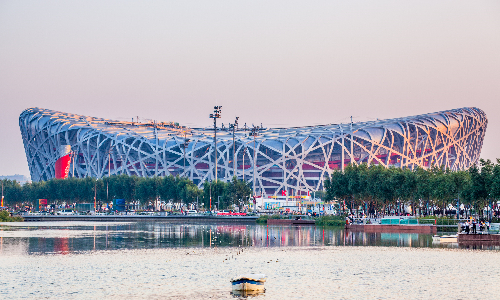
Today you can arrange your time as you like. If you want to go around the urban area, some popular attractions like the Temple of Heaven, 798 Art District, Silk Street Market, Wangfujing Street, Houhai Lake, and the Sanlitun Area are highly recommended.
Free Time Suggestion:
The Temple of Heaven, as the most representative of Chinese ritual architecture, is the largest heaven-worshipping architecture in the world. It is a good place to explore ancient Chinese architecture. It was built in 1420 in the Ming Dynasty. The Temple of Heaven is famous for several magnificent ancient buildings. The Hall of Prayer for Good Harvests is the place where emperors of the Ming and Qing Dynasties prayed for a bumper harvest. This circular building is 33 meters high and possesses three floors decorated with blue glazed tiles. Under the blue glazed tile is the most complicated wooden structure of the hall. The wooden columns are all distributed in multiples of the number 4, representing 4 seasons, 12 months, and 24 solar terms of the year respectively. What’s more complicated is the ceiling structure that is distributed radially from the center, forming many concentric circles. Located on the south side of the Hall of Prayer for Good Harvests is the Circular Mount Altar, where emperors came to offer a sacrifice to Heaven on Winter Solstice. If someone makes a sound standing in the center of the altar the sound will be reflected three times, forming echoes from all directions. It is in this way that the ancestors created an atmosphere of dialogue between Heaven and human and offered worship to Heaven and Earth.
If you are an art fan, you must go to the 798 Art District in Chaoyang District. It is a creative district where you will find well-designed architecture and many art exhibition galleries like UCCA Center for Contemporary Art. It was originally an old factory area and now there are more than 3,000 artists from all over the world. As a symbolic place to present contemporary artistic achievements, 798 Art District attracts millions of audiences every year. It is a new landmark of Beijing’s urban culture and a holy place for young artists to experience fashion life. Walking into this place, besides sculptures with different gestures standing along the streets, you can see many public works of art in outdoor space, allowing you to get closer to art.
Silk Street Market is also located in Chaoyang District. It is a noted shopping market in China with the same position as the Great Wall and the Forbidden City. You can find a myriad of charming objects in the market, including handicrafts, silk products, antiques, fashion accessories, and other products with Chinese characteristics. Many celebrities at home and abroad, such as the wives of politicians from all over the world and the son-in-law of former US President Donald Trump, have come to shop here. You will also find your favorite souvenir in the market.
Wangfujing Street integrates traditional architecture with the modern market. At the entrance of the street stands a beautiful antique archway with a height of more than 10 meters. The street is divided into four areas, all of which are based on the architectural style of the Ming and Qing Dynasties. Apart from offering daily necessities, clothing, jewelry, and diamonds, it is also a gathering place for famous specialties in Beijing and other places.
Houhai Lake is an amusement place for locals to go boating in summer and go skating in winter. The history of Houhai Lake can be traced back to the Yuan Dynasty(1271-1368). Many buildings around the lake remain typical characteristics of traditional buildings in Beijing. Walking into the Hutongs next to Houhai Lake, you will find fashionable bars as well as all kinds of old shops. Here is a good place to relax.
Sanlitun Area is a popular destination for shopping, dining, and entertainment where bars first gathered in Beijing in the late 1980s. It might be the noisiest block in Beijing at night. In addition to the international brands like the newly renovated Apple flagship store, there are many boutique stores hidden in the streets. Walking along the way, you can see senior citizens who are enthusiastic about dancing in the square, and you will also pass by many pubs and bars. The embassies of more than 70 countries, such as Turkey, Mexico and Denmark, are also located here. Maybe that is why you will find a lot of foreigners at Sanlitun.


 Chengdu
Chengdu Till now, your visit to Beijing is going to end. We will send you to the airport to take the estimated flight MU9698 11:40/14:40 to Chengdu. Have a safe journey and your guide in Chengdu will meet you at the airport and take you to the hotel for a rest.
This morning you will visit Chengdu Research Base of Giant Panda Breeding. It is a world-class giant panda breeding research base established to save the endangered pandas. The base integrates natural scenery with the artificial landscape, with a green coverage rate as high as 96%, creating an ecological environment suitable for giant pandas and a variety of rare wild animals to live in. You can also visit the giant panda’s baby room to learn about the breeding of giant panda babies. Besides giant pandas, there are black-necked cranes, white swans, black swans, geese, ducks, peacocks, and other animals in the base. You can interact closely with these lovely animals here.
The afternoon at People’s Park is a good time for you to experience the leisure and comfortable life of Chengdu. Every year, the Chengdu Chrysanthemum Exhibition with as many as 1,000 varieties of chrysanthemums are held here in October and November. Besides enjoying flowers and taking pictures, you will also see many people dancing here. The park enjoys a reputation for its largest teahouse in Chengdu named Heming Teahouse. The teahouse boasts a history of more than 90 years. Here you can listen to Chengdu’s tea culture history while enjoying the top-grade tea.
There is a very famous period in Chinese history, the Three Kingdoms Period (220-280). Wuhou Temple is an ancestral hall to commemorate Zhuge Liang, a great politician and military strategist in this period. The temple was named after Zhuge Liang who was bestowed with the title of Wu Hou(a title of nobility). The temple covers an area of 150,000 square meters. Different historical figures are enshrined in the halls, such as Zhuge Liang, Liu Bei (initially a general and a warlord, and later the founding emperor of Shu State during the Three Kingdoms Period), and Guan Yu, a major general loyal to Liu Bei (noted for his brilliant success on battel field).
Jinli Street, adjacent to Wuhou Temple, is a commercial pedestrian street with a total length of 550 meters. The buildings here adopt the architectural style of Sichuan’s ancient towns in the late Qing Dynasty. The street is lined with teahouses, inns, theaters, handicraft workshops, and gourmet shops. It is also a street full of hawker stalls, where you will enjoy all kinds of famous snacks with the most Sichuan characteristics. Every year, Jinli Street holds folk performances such as traditional weddings, folk music, dramas and folk costume shows, as well as special theme activities concerning traditional Chinese festivals, such as Lantern Festival, Dragon Boat Festival, Chinese Valentine’s Day, and Mid-Autumn Festival. Here you can fully experience Chengdu folk customs, leaving mind-blowing memories.
Watching Sichuan Opera is a popular activity which you must experience. The best place to enjoy it in Chengdu is Shufeng Yayun Theater which gathers a number of famous performers from the Sichuan Opera industry. You can also enjoy performances like hand shadow play, puppet show, clown play, face changing, fire breathing, traditional Chinese instrument performance, and so on. Face-changing is a stunt used in the art of Sichuan Opera to shape the image of characters. Different masks represent different attitudes and moods, such as fear, despair, anger, etc. Skilled actors often change dozens of different masks in a very short time by raising hands or tossing sleeves during the performance. The showtime is 18:00-19:30 or 20:00-21:30. Before watching the show, you can visit backstage. If you are interested, you can pay for makeup and take a makeup photo of the Sichuan Opera as a souvenir.

 Shanghai
Shanghai This is your last day in Chengdu. This morning is reserved for you and you can take a rest at the hotel to prepare for the next city trip. In the afternoon, you will be transferred to the airport and take the estimated flight MU5418 16:00/19:00 to Shanghai. Your guide in Shanghai will meet you at the airport and send you to the hotel.
You may have already heard that Shanghai is an international metropolis before coming to the city. But over one thousand years ago, it was only a fishing village. It is also a historic city with many cultural and historical sites such as Jade Buddha Temple, Shanghai Old Street, and Yu Garden.
After breakfast, you will visit Jade Buddha Temple. The temple will leave a deep impression on tourists with a large number of statues. It was originally built to accommodate two jade Buddha statues from Myanmar. But as time goes by, it collects more and more magnificent statues. In the main hall, three golden Buddhas stand solemnly, representing the past, present, and future respectively, while the Heavenly King Hall has four heavenly kings who are the guardians of Buddha. Chinese Buddhists believe that the king holding swords protects the Dharma from infringement; the king taking the pipa (Chinese string musical instrument) use music to convert sentient beings to Buddhism; the king holding umbrellas protects the world from demons and safeguard the wealth of common people; the king holding snakes is the chief of the dragon gods. Close contact with the four heavenly kings will help you better appreciate and understand Chinese Buddhism culture.
Then you will visit Yu Garden (closed each Monday). It is the most classic garden in the city, and its history can be traced back to the 16th century. It was originally built as a private garden of Pan Yunduan, an official in the Ming Dynasty. Here, you will find six major tourism areas containing luxuriously decorated bridges and colorful pagodas, and about 30 exhibition halls. Besides, of many old and famous trees here, 20 are over 100 years old. An ancient ginkgo tree in front of the Wanhua Building aging more than 430 years, with a height of 26 meters, stands upright like a giant.
Then you will stroll on Shanghai Old Street located in the center of the city. It is a street integrating sightseeing, tourism, and entertainment. Although it lies in the international metropolis, this old street is full of ancient flavor and retains the appearance of old buildings. When you walk into the old street, it is like walking into the bustling Shanghai 100 years ago. There are many historical sites and shops on both sides of the road, such as old-style Chinese private banks, commercial firms and tea houses. There are also many buildings imitating those of the Ming and Qing Dynasties, which are worth visiting.
After lunch, you will get to the Oriental Pearl TV Tower. It is the most famed landmark in Shanghai and the best viewing platform is located here. The TV tower has three large spheres. The top sphere is called the Space Hall, with a total of 4 floors. There are 9 floors in the upper sphere, and the revolving restaurant is located here, which can accommodate 350 tourists. The lower sphere has 4 floors, including indoor playgrounds. You can overlook Shanghai’s beauty on the sightseeing terrace on the upper sphere.
Next, we will visit the Bund. Its essence lies in the World Architecture Expo Group, which is a building complex with different architectural styles, including English, Italian, Roman, Gothic, Baroque styles, and so on. Gorgeous European architecture, restaurants, and shops are arranged along the Bund. You can also take photos with the Oriental Pearl Tower across the Huangpu River.
As the earliest commercial street in Shanghai, Nanjing Road witnessed the development of Shanghai’s commerce. Next to the Bund, Nanjing Road stretches about 5.5 kilometers. It has become the most visited road in Shanghai. Walking along the retro and modern road, you can see the centuries-old Chinese brands and stores from all over the world. Apart from world brands like Champion, Sephora and Dior, the second flagship store of Lego in Asia is also located here. You will appreciate the elegant architecture of the surrounding buildings and marvel at the countless illuminated advertising boards along the way.
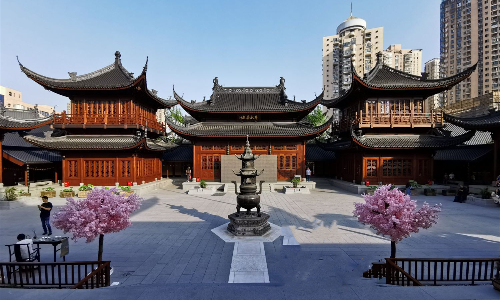
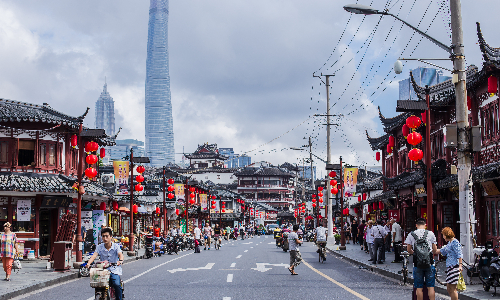
After breakfast, we will drive for an hour and a half to Zhujiajiao Ancient Town. It is a water town with a long history and is located 50 kilometers west of the city center. This ancient town flourished in the Ming Dynasty. Today, the town maintains many old canals and bridges connecting dozens of charming narrow streets. The most noted bridge, the five-hole stone arch bridge, can be traced back to the Ming Dynasty. The town is also filled with tea houses and stages, and attracts a large number of Chinese and foreign visitors every year. Many international cultural activities are often held here, including forums and music festivals. There are hand-cranked awning boats and electric boats on the river. Besides shopping in the town, you can take the boats to enjoy the scenery on both sides of the river.
Next, you will go to visit Tianzifang Market. It is the place where traditional Shikumen houses are best preserved. Shikumen, which literally means “stone gate”, is a typical residence with two or three-story houses and stone-ringed doors in Shanghai. The third floor of the old Shikumen residences is used for residential rooms, while libraries, handicraft shops, teahouses, galleries, photography exhibitions, art studios, and cafes are arranged downstairs. In addition to the distinctive buildings, when you walk into the market and walk through the alleys, small shops, bars, and art workshops with special characteristics will jump into your sight. If you feel tired, you can take a rest in the café or the tea house.
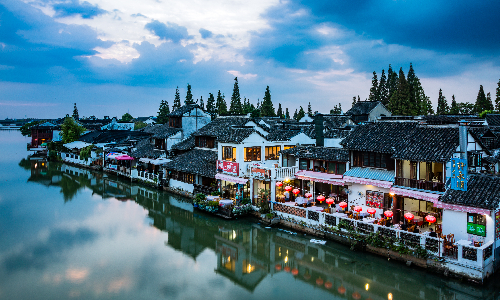
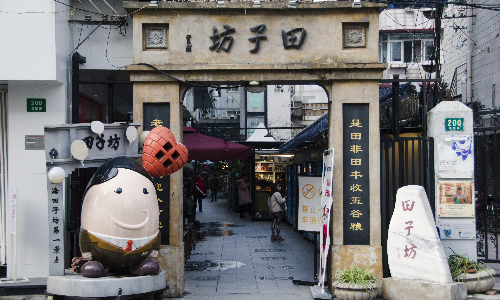
Till now, your visit to China is going to be over. Your guide will transfer you to the airport according to your flight schedule. We kindly remind you to check your luggage before leaving the hotel. Thanks sincerely for your trust during the tour and wish you all happiness.
Editor: Liu Tianhua
Proofreader: Summer Hou
| City | Five Star hotel list | Four Star hotel list |
|---|---|---|
| Beijing | Sunworld Dynasty Hotel Beijing Wangfujing | Sunworld Hotel Wangfujing |
| Chengdu | Sofitel Chengdu Taihe | Holiday Inn Express Chengdu Jinniu |
| Shanghai | Ocean Hotel Shanghai | Courtyard by Marriott Shanghai Central |
 |
![]() About your child or infant, please contact us for a discounted price.
About your child or infant, please contact us for a discounted price.



We started with a few days in Beijing & ended in Shanghai, from where we visited the Forbidden City and Great Wall. In between we visited Terra Cotta Warriors Museum, Panda Base, Shanghai Disneyland.

We had a wonderful holiday in China which will remain long in the memory. China is a breathtakingly beautiful country full of splendid temples and palaces, mountains and rivers, peaceful rural scenes and bustling shopping streets.
 QUICK ENQUIRY
QUICK ENQUIRY